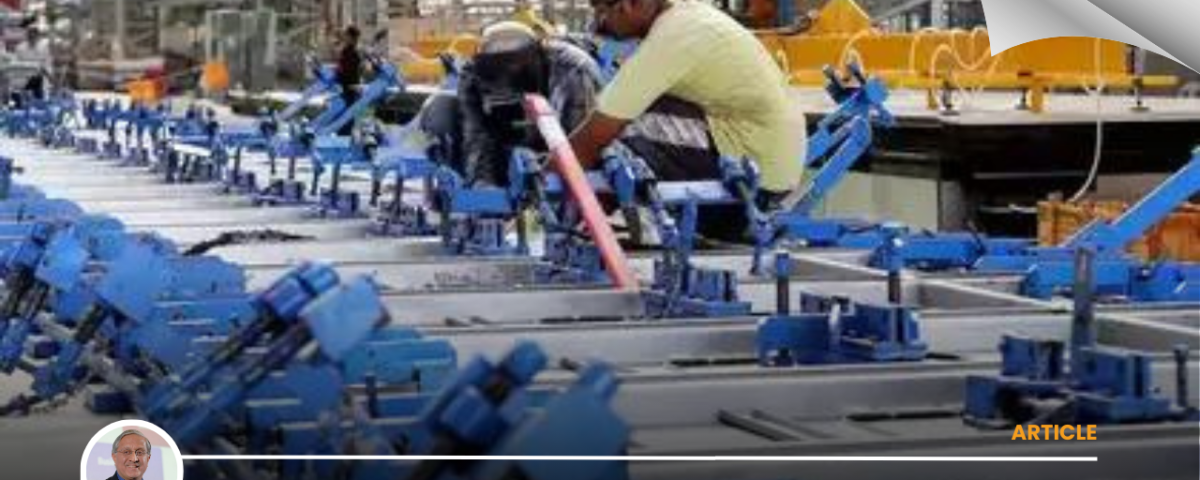5th Jun 2016, ECONOMIC TIMES
By R Gopalakrishnan
Make in India (MiI) was announced on 25th September, 2014 in the hope that more manufacturing means more jobs. Make in China 2025 (MiC25) was announced on 20th May, 2015 in the hope that more manufacturing can be done with less jobs! Silicon Valley’s controversial Marc Andreesen says, “Manufacturing is a government-subsidised jobs programme.”
What is happening to manufacturing/making? What are the implications for India?
Gideon Rose (editor of Foreign Affairs) haunted me with his view on manufacturing, “Something is clearly happening here, but we don’t know what it means. And by the time we do, we may well have been replaced by algorithms.” Seventy percent of the world’s robots are sold in four countries—US, Germany, Japan, and, hold your breath, China! China’s Midea is making a USD 5 billion bid to buy Kuka, Germany’s leading robotics company. In The future of technology and jobs, Dr R.A. Mashelkar acknowledges that the new type of manufacturing will destroy jobs, but hopes for new ones somehow or the other.
The recent China Global Investment-Shenyang Euromoney Conference gave me much learning from my three knowledgeable co-panellists: one from China’s Robotics Company, one from a Sensor Company and another, the Vice Chairman of the Sino-German Cooperation: first, the back story.
In 2011 the Germans first contemplated Industrie vier punkt null (Industry 4.0). Stalwarts Siegfried Dais and Henning Kagermann studied the subject with experts and reported back at the Hanover Fair 2013. Promptly Chancellor Angela Merkel adopted it as a national program–intelligent manufacturing, which means applying the multiple tools of information technology to production. Global interest in Industry 4.0 zoomed to stratospheric heights, thanks to the commentaries of consulting companies, and the eponymous Klaus Schwab report at Davos. Why 4.0? 1.0 was mechanization of production using steam, 2.0 was mass production using electricity, and 3.0 used ‘simple’ digitization. ‘Complex’ digitization facilitated Industry 4.0.
The Chinese reaction was swift; Ministry of Industries and Information Technology (MIIT) breathtakingly announced, “Upgrading of China’s manufacturing industry has become urgent as its status as the world’s factory is undermined by developing countries, and it seeks a new engine of growth amid a slowing economy.” That is how the Chinese cabinet adopted MiC25. Gosh, if it is urgent for China, what about India?
All over the world, the impact of Industry 4.0 is being increasingly felt by people, business, and government.
For sure people will get impacted because, for the first time, high growth does not equal more manufacturing jobs. China is driving its Make in China 2025 agenda because its labour is becoming too costly. The middle of the labour market is being hollowed out; low wage-low skill and high skill-high wage at the two ends survive. India has a window of ten years for labour-arbitrage based manufacturing, but must plan for something thereafter. India’s manufacturing owes much to the middle of the skill-wage map. Industry 4.0 can dehumanize people.
Business has been impacted for some years now. The supply chain and productivity efficiencies leapt out during our visit to BMW Brilliance’s world-class Shenyang car factory. Due to deployment of 85% automation in the body shop through 675 robots, hardly any workers were visible on the shop floor. Apart from producing the premium BMW cars, this JV has produced, ground-up, the first zero emission, electric car, branded as Zinoro.
Government is being impacted by smart manufacturing. From phase 2.0, governments got used to solving problems in a linear, top-down manner. The Shenyang government is a minority shareholder in the JV, and it helps by avoiding interfering. “Now governments have to adapt by learning how to collaborate with business and society,” explained one Shenyang official. Here is a human interest example of government reorienting to collaborate and support.
Narendra Chavan was appointed as CEO of NTACO, the Nanjing subsidiary of Tata Auto-Components. Soon after Chavan arrived in the Nanjing factory, the HR head learnt that the one passenger was suspected of having bird flu as detected by the sensor gun. The authorities needed to quarantine for a whole week all passengers from the three rows in front as well as back of the suspect’s seat. NTACO’s attempted to quarantine Chavan in the company-booked hotel was rejected; Chavan went to their unpretentious hotel being used for quarantine–a sparse room with a small TV, clean bed and attached toilet. They allowed some magazines, cold drinks and food from NTACO but no visitors. Chavan was required to wear a face mask, especially while emerging from his room for food.
During the seven days of doctor visits, temperature recording and physical checks, Chavan contemplated the scenario if an expatriate faced a similar situation back home. However the attitude of the authorities was exemplary. After a whole week, Chavan found that of those quarantined, most were foreigners. Even after his return to NTACO, government officials called on him to show empathy. Local officials arranged a dinner next day. Chavan felt that the government officials connected with the companies, they communicated well and were very sensitive. To Chavan such humanism has to be part of any “Make in” program.
India can attract through Make in India some low-cost manufacturing for maybe ten years. Importantly India is uniquely positioned to leverage the global phenomenon of 4.0 because India has middle order skills in both manufacturing and software. 4.0 can be to manufacturing what Y2K was to business software.
DIPP, Niti Aayog, NASSCOM and CII should recommend a policy to the government, which can consider an India-Germany 4.0 initiative between Chancellor Merkel and PM Modi.



